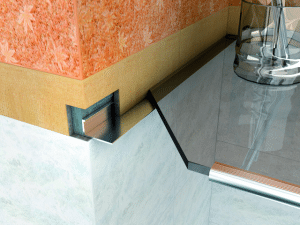How is Aluminum Trim made and what are some common types?
Aluminum trim is an aluminum product that is produced by extrusion to create long, narrow, pliable, and adaptive pieces of tile trim that can be used for architectural decorative applications and accents, indoor and outdoor lighting, and engineering design. The use of aluminum trim results from the many positive properties of aluminum; these include its resistance to rust and corrosion as well as its low density.
The process that is normally used to produce aluminum trim edging is extrusion, one of the most reliable methods for producing high-quality products with excellent endurance and appearance. Extrusion has proven to be the most efficient and effective method for the production of aluminum trim since it is economical and provides instant results. The many profiles of aluminum trim have excellent tolerances and exceptional dimensions, and precisely meet the requirements of the product‘s design.
The many qualities of aluminum are maintained in aluminum trim edging that can be adapted, shaped, and fitted for use in a wide variety of applications. One of the main uses for aluminum trim is as a sealing agent and decorative addition to boats, motor homes, appliances, and shelving, to name a few. Here are some common types of aluminum trim:
- J Trim – commonly used on the edge of aluminum siding around windows and doors and on the top of the siding to hold the siding in place. The proper installation of J trim serves as a seal for a project and protects a project from leaks and the build-up of moisture.
- U Trim – this type of tile trim has been used for many years as a method for finishing edges and protection against the roughness of unfinished edges. It is used as a method of adding an aesthetic appeal to a project and reducing fabrication costs.
- Z Channel Trim – Z channels are used with metal roofing and act as a receiver for panels, ridge caps, and headwall flashing. The main benefit of Z channel aluminum trim is its ability to prevent leaks due to its directionality.
- H Channel Trim – H channel aluminum trim is similar to the C channel with the same inside radius corners. It is ideal for applications that require strength and stability. It is commonly used on railings, as decorative trim, or as door and window frames.
- T Edging – T aluminum trim is useful for architectural planning and millwork. It is used for store fixtures, displays, chairs, elevators, and finishing for woodworking projects. One of its main uses, due to its strength and endurance, is aluminum trim edging for tile to prevent the tile from chipping and as a transition for tile floors.
Aluminum trim functions as the final part of a project that provides a finishing touch, a tasteful decoration, a protective surface, and an eye-catching highlight. Alusite has extensive experience in dealing with aluminum trim – both for industrial and residential projects – feel free to contact us for more information or a quotation for all aluminum-related matters.

